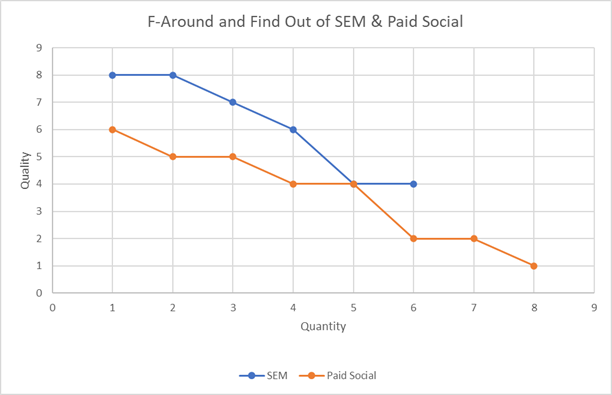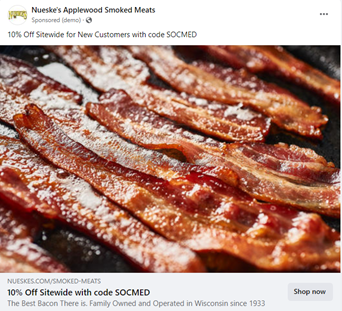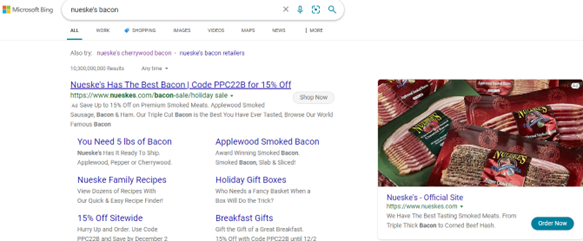Hello, my fellow search and biddable media industry friends.
For those that watch, follow, and/or troll my Twitter account, you’ve seen me on #ppcchat bashing things like Pmax, Auto-Apply Recommendations, and GA4.
That’s in addition to my usual rants about the New York Jets (but hey, they’re 4-2 as of writing this), and social commentary on all of the Real Housewives franchises.
Today, we’re going to chat about when you should use search engine marketing (SEM), paid social, or both.
Full disclosure: I am not a “guru” (I truly hate that term), nor am I the best thing since sliced bread in the biddable media industry.
But I’ve done this for a long enough period and worked with enough brilliant people and brands to be considered a somewhat reliable source of insight.
But Jon, they are both biddable media; shouldn’t they always go together to achieve a holistic goal? No.
Why?
Because: SEM and paid social are not necessarily apples-to-apples but more like “a starfruit and a 1992 Volvo 240 with a spoiler on it.”
This is to say: one is fun and interesting, and one is often ugly as sin and easily misused but serves a hearty purpose.
What Are SEM And Paid Social Media Advertising?
The reality is that they are different functions.
Paid social is considered proactive media, meaning that someone isn’t necessarily looking for information, but receives the ad. (In reality, nearly all digital media is proactive.)
SEM, on the other hand, is reactive media – someone is actively looking for something, and the advertiser is meeting them with the related ad.
Doing them together at equal allocations to achieve the same purpose is a perfect example of the popular saying and meme, “F-Around and Find Out.”
F-Around and Find Out: The value correlation of SEM and paid social.
 Image created by author, October 2022
Image created by author, October 2022Despite the absolutely hilarious title of the chart, it does serve as an explanation: Yes, you can do it all at once, but the output of it will vary based on its purpose.
At some point, the co-mingling of SEM and paid social will meet if unmonitored. However, the reliance, whether on volume or customer qualification, may be less than desirable.
The Benefits Of SEM Vs. Paid Social
As a general common-sense rule within the industry, make sure you remember the following:
- Paid social might get you last-click conversions/sales/leads, etc., but in reality, it works like display and video, helping you garner more awareness or re-engagement. It is about getting better and more direct conversions, but still not the best.
- Paid search/SEM has high intent for faster conversion/sale/leads, because the consumer must trigger your ad. It’s not the best tool for driving awareness. Search does an okay job at injecting your brand into the search engine results page (SERP) if you aren’t a known player, but be wary of the “branding” lift you get out of it.
Takeaway: SEM drives actions, and paid social drives awareness.
So, how do you know when to use each one?
Well, if you’re asking yourself that, perhaps you are not paying close enough attention to the graph or prior explanation of proactive vs. reactive.
So, let me explain it in a bulleted, more simplistic/media-esque way:
- Organic social: While not what we’re discussing here, your organic social represents what you can control – your owned media. You can use paid social to push it further.
- Paid social: Used to further push your amazing organic social and drive new followers to your page, so you can guide more owned media toward them. Or, drive them straight to the site to push further awareness/to harvest their data, in addition to trying to sell them something directly. These users may or may not be actively looking for what you want to sell them, but you have special tools that help you determine if they may be.
- Paid search/SEM: You have something you want to push to people, but you only want to push it to people who are looking for your thing (or something similar to it). So, you come together on search engines and provide them with a portal to the item they may be looking for directly.
Now that I’ve reiterated what you probably already know, let’s discuss which one should be used, when, and why.
When To Use SEM Vs. Paid Social
- If your end goal is to drive direct-from-site sales/leads/website-based engagements, then lead off with SEM.
- If your end goal is to drive brand or product awareness or re-engage with prior users/visitors, then lead off with paid social.
That said, there are multiple reasons to run both at the same time.
Some of the most straightforward scenarios include:
- Remarketing clean up: Someone searches and enters the site on a Google ad but abandons – that is when paid social (or really any programmatic) can hunt down the searcher with the same thirst for blood as the TSA agent at LaGuardia airport, searching for my half-full water bottle.
- Capturing the mid to low funnel: A person busy arguing political points on Facebook who is shown an ad pushing mouth-watering bacon will then go do even more research on Bing (I refuse to call it Microsoft) in hopes of finding a better discount code.
Here’s a paid social awareness ad, helping to push brand recognition:
 Image from Facebook, October 2022
Image from Facebook, October 2022
And here is the search ad that garnered brand recognition and traction when paid social was pushed:
 Screenshot from search for [nueske’s bacon], Bing, October 2022
Screenshot from search for [nueske’s bacon], Bing, October 2022- Stacking the remarketing lists: A personal favorite of mine is using SEM to “inject” more highly-qualified consumers to the website, and the converters to grow my social CRM/remarketing lists – which, in turn, leads to creating bigger and more accurate lookalike audiences for paid social.
What Is The Right Mix of SEM And Paid Social?
The right mix is a moving target and, to a degree, subjective. The levels vary by vertical, seasonality, and end intent.
I recommend setting a primary and secondary focus.
If the primary focus is direct conversions, lean more heavily into SEM.
If it is awareness/engagement, lean more heavily into paid social.
The best thing you can do is pull from historical data to decide.
If you don’t have historical data, go into pure testing mode: Start with a 50/50 split in investment, and within 48 hours, you’ll have a sense for search impression share (and hopefully conversion data), and it can help you decide if you need to shift funds one way or another.
The two will work together, providing the correct objective is set for each:
- SEM: Direct to site, convert, and capture those moving down the funnel.
- Paid Social: Awareness, re-engagement, and moving a consumer along the funnel.
Only you know which is right for your needs.
Just remember: Wach channel serves different purposes, so keep the mind open and the budget fluid.
More resources:
- Paid Social & Paid Search: How to Have A Happy Marriage
- Paid Social Media: A Guide To Social Advertising Success
- Social Media Marketing: A Complete Strategy Guide
Featured Image: fizkes/Shutterstock





